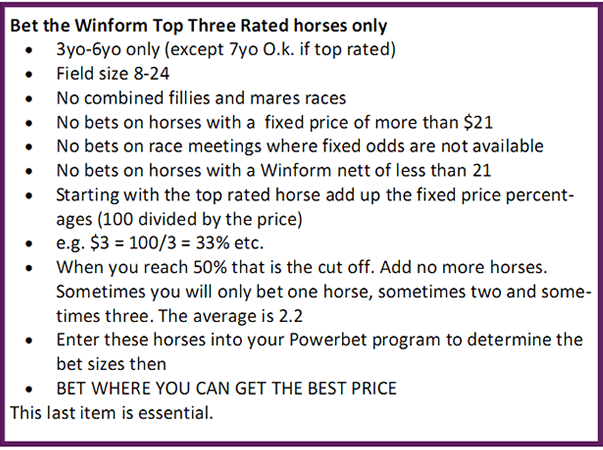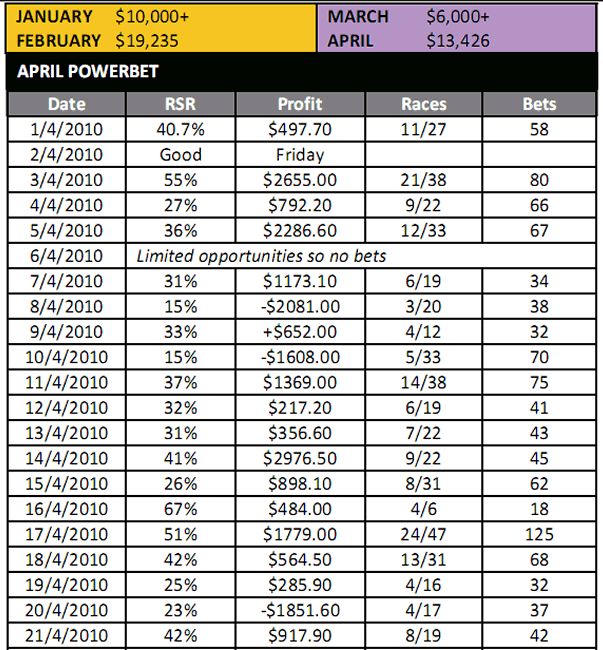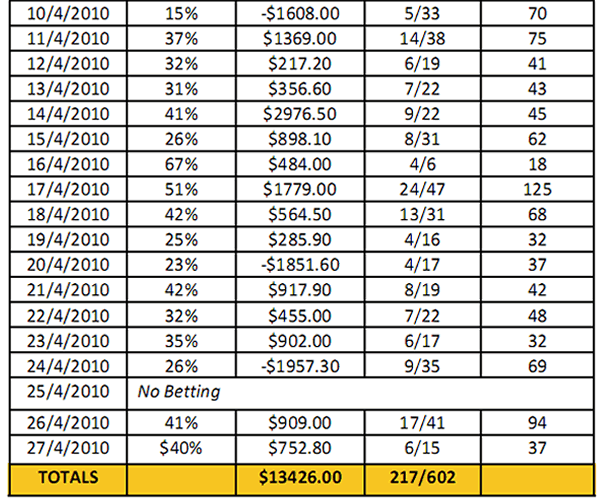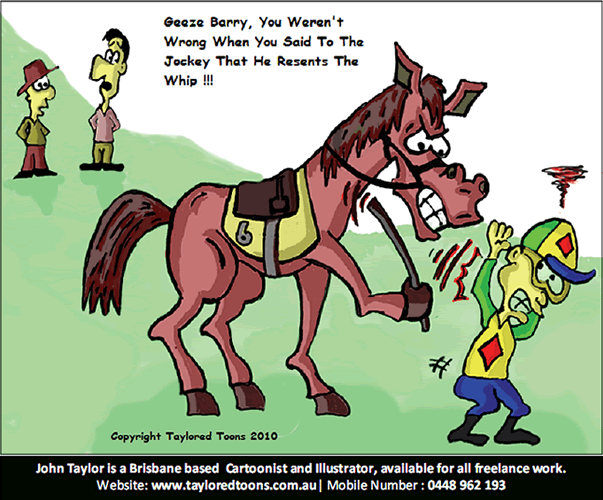Firstly a bit of history. In 2002, one of our Members, Brenton Burford, called us and said: “Did you realise just how many long shots you guys get in the Winform Top Two?” To be honest, we didn’t. At the time Brenton was using a staking software called the Scud. It was designed for those who wanted to put on their Saturday bets and then the next week have the bets adjusted depending on what happened previously. The plan worked O.K. and required winners in the $5 to $10 price bracket to be successful and it was, but all plans can be improved.
We worked in conjunction with Brenton and the programmer and came up with what is now known as Powerbet. It took over 30,000 bets to create Powerbet after all the testing and betting in every race every day. Fortunately, we were making money at it as well as developing the system. In fact the first day Amelia (my assistant at the time) and I used it we backed a 100/1 winner.
At one stage we examined 3802 races between April and Mid October 2002 and came up with an interesting result for the Winform Top Two. In 19% of the races you would have made a profit of less than 100% Dutch Betting the Top Two. On the other hand 81% of the time a profit of 100% or more could be made.
So. Simply betting the Top Two on a Dutch bet when you could double your money, was a winning strategy, making $100.70 for every $100 outlaid. Not much you say? Well think about it. Multiply all the races run each year and collect seventy cents for each one. Now you see, don’t you?
There is a problem. It doesn’t always run as sweet as that and therein lies the basic problem betting with level stakes.
In the eighties there was a syndicate of Melbourne doctors who bet on every race to make a mere $2 on each race. They actually made $30,000 over a period of a few short months and it worked like this. Bet $2 on the favourite and if it loses bet $2 on the next favourite plus enough to win back the original $2 that was lost and so on. This was on dogs, trots and gallops. Hundreds of races a week even back then in the eighties. The worst run of outs the syndicate had was minus $7,500 and with a bank of $58,000 (there were 29 shares at $2,000 each) they were never in trouble.
There was a problem. One of the syndicate members needed some money and took off with the cash and that was the end of it. My brother in law and I had a go at the plan a couple of nights on the doggies and did alright but it was boring so we let it go.
I knew of this story through one of the shareholders and so I got my daughter’s boy friend Michael to dig out all our old records, put them in date and time order, and try the plan with my bets. This was in the early nineties before we had a computerised data base. The plan made a good profit but on one bad run, the bank was minus $50,000 before a profit was made. I never would have had $50,000 to bet with back then. I couldn’t afford to lose $50,000 now either.
In developing Powerbet we soon realised we were on a winner. We used a similar concept to the above. We simply bet a level stake on each of the top two rated horses in each race. When we lose we bet the same level stake bet on the next race AND add a little extra to recoup all or part of our previous losses.
So what’s the worst thing that can happen to you when you try to recoup your losses? Not sure?
Give up? It’s a run of short priced losers. And why is that? Simple. To recoup your losses you need to bet big. Bet big and lose and your bank is soon lost too.
Powerbet overcomes that problem by only trying to take part of the loss back on the shorter priced horses. On horses that are in the $5 to $9 bracket, one win will usually clear the series or at least reduce it substantially.
Of course as I previously noted, there can be horrendous runs of outs and so a new and unique strategy was called for.
At stock market seminars there was always the necessity to set a stop loss. This came about after the October 1987 stock market crash which was when I lost my Super fund for the first time. I had been to several stock market seminars and for your money you usually got a blue chip strategy. The idea was that you took a blue ribbon stock at say $9. If the price went up 10%, you sold. If it went down 10% you sold. History, a very good teacher, suggested that for every Blue Chip stock that went down, two went up and so all the stockbrokers lived happily ever after. Now where were we?
That’s right. We decided we needed a stop loss strategy for our betting and we settled on 10% of our bank.
If you are using a $10,000 bank the idea was to split that into ten $1,000 betting series or minibanks. By trial and error we discovered that it took a losing run of 14 races to lose our series but had we persisted, only another three , or four races to double our losses so 10% it was. With further trialling we found that we probably only needed five of these minibanks but hey! Let’s be conservative. The punter that busted four series in a row might just baulk at laying out his last set of dollars. With a maximum of 10% at risk at any time, we’re not likely to drop more than 50% overall and hopefully we would have accumulated many winning series.
Brenton Burford, once we had created the Powerbet program, was keen to trial it his way. Instead of clearing each series as it made a profit, Brenton increased the base bet and carried on. In doing so he multiplied his $1,000 starting bank many times until it reached about $17,000. Sadly, it only takes one losing series to give it all back and that is what happened. Brenton was philosophical about the loss.
“Really” he says, “I only lost $1,000.” Soon after he ran a series up to $7,000 before this too was lost in one afternoon. But that was back in 2002. I have been wondering about our new Powerbet strategy and after a particularly good run in April I ran the figures through and here’s what happened.
Between April 1st and April 7th there were 38 series completions in a row. Starting with a $2,000 bank that bank reached $2500 by the end of the first day. April 2nd was Good Friday so no betting and Saturday the third was a good day with the bank rising to $6,000 by the end of the day.
Now the base bet on Sunday was soon $70 and rising. By Easter Monday we were regularly placing bets of up to $200 and regular winners abounded. By the time we had snared a winner at $54 at Pinjarra we were betting with a series of $19,000 and the slaughter continued.
Tuesday there were two race meetings with many small fields and no bets were placed but Wednesday it was on again and by the last at Canberra we landed a $7.70 winner and our bank had reached $60,000+ for a profit of $58,282.35. It was a great run which would be seldom repeated. The average dividend for this period was $8.70 and strike rate 19%, compared to $6+ and 16% in a normal period, if there is such a thing.
In my original Powerbet book we observed that on average we had ten completed series for every one lost. It is probably worth a risk to run with this on a small bank to see what can be achieved and as I write this I have persuaded Brenton Burford to give it a go. We are setting a limit of a 500% series increase or ten series completions, whichever comes first.
If we nail it just once we can drop up to four series and still be in front.
In October 2002 we had run a similar strategy and between the 26/10/2002 and 31/10/2002 we had twenty series completed taking a $1,000 bank to $18,061.
One by one, our Ratings Subscribers and Powerbet users came up with strategies of their own. Gavin, for example, refused to bet in races unless at least one of the two runners was $8 or better. He won over $30,000 in one month but endured some long runs of outs over the ensuing months but the strategy wasn’t too bad.
Another Subscriber, Trevor, carefully watched the day’s race meetings and only bet in those which in previous years had proved profitable. He was very successful over a number of years until a brain tumour stole him from us. We spoke regularly, right up until he was hospitalised. Trevor was a very sensible and crafty punter.
Amelia Burton in her book; ‘Punting In The New Millennium’, which was released in 2004 and was a sell out, found a winning strategy as follows.
Looking at the Winform Top Two, eliminate races longer than 1700 metres and races run on a heavy track. Now check if on a Dutch bet a 100% profit can be made. If it can, then these are the races to bet on. From June 2003 up until December 2003, the profit was $18,925 betting $100 per race. The race strike rate was only 26% and this means that we would lose a lot more Powerbet series. The average dividend was good.
In the ensuing years we spent a lot of time and energy developing the Professional Edition of Money Factory and the popular C Plan which are both very well used by our Professional punting Subscribers. In addition we continued to monitor and develop our Premium Selections. To be totally honest Powerbet continued to be used by many of our subscribers but we didn’t do anything much to promote it.
In 2007, Trevor Johns approached us about a new Powerbet method he was testing and in no time at all we had a very new and different way of using Powerbet. Originally, remember, Powerbet was designed to bet the Top Two Winform horses. Trevor was showing us how you could use it with four horses and still make money but not necessarily using Winform exclusively.
One of the bugbears of betting a plan such as Powerbet race to race is that sometimes you don’t know the result of a previous race or there is a protest which holds things up. With John’s idea you simply bet each race meeting separately which eliminated that problem. As a profit was made, betting at that venue was finished for the day.
In January this year we had a bit of a brainstorm. Let’s revisit Powerbet and see how it is doing in 2010. We ran the figures through based on making a $200 profit each day and quitting and also quitting if we made a loss. At the end of the month a satisfactory profit was made and so Powerbet was still a goer. But is there a better way?
My mate Trevor had concentrated on meetings which were good for the Winform Top Two but a lot of meetings and a lot of races were cut out, plus these results can change with time. Another niggling little problem is that as track conditions change, so do the Ratings. The changes aren’t great but they often change the order.
So here’s the problem. We based Powerbet on getting 34% race strike rate using two horses per race. We had experimented with betting the top three horses per race, as this just about solved the track change problem with the change in order being the worst result but mostly the same three horses would come up.
The problem was that betting three horses per race meant the losses in the total loss column which governs the bet sizes, was much greater, leading to more series closing with a loss.
Then I had a thought. What if I applied the 100% rule that was previously successful with the Top Two. This meant that in some races I would bet only the top rated horse plus most times the second and sometimes the third horse. It made sense to me because when I looked at the average dividend of the third horse there were some spectacular dividends. The race strike rate of the Winform Top Three was over 47% at an average of over $6.
I ran a few tests and found that there were 2.6 horses selected on average. Too many. I started to analyse my GTX System Developer database and soon found some eliminations. The aim was to trim out those selections or races that didn’t contribute to the overall profit.
With our Powerplay program for our Professional Punters I had already started the weeding out process and had discovered that horses longer than $21 fixed price with Bookmakers, actually won just 1.7% of their races even though they were highly rated . In spite of sometimes costing ourselves a long shot winner, overall the loss was dramatic. We tossed these out.
In January and February this year there were 378 of these selections for just one single winner. It is painful to pass up a $50+ winner but in the long run we are better off doing so and besides, we have seen plenty of $15, $17 and $21 shots pay $30, $40 and $50 on the totes.
Another variation was looking at field sizes. Small fields are often very competitive with the odds changing frequently and almost always being unders’ as Bookmakers ease the risk.
Many of these races become tactical events with a lot more interaction between jockeys. In addition, the chances of a horse getting cluttered up, is less likely. After analysing these races, we found that although the race strike rate was excellent, the average dividend was a lot less than we needed. Taking these races out reduced our race strike rate to 38.7%, but we were getting closer to getting even on level stakes simply backing all runners.
As part of my analysis I had a good look at races for the fairer sex as this seems to be a bone of contention whenever punters get together for a chat. In Fillies and Mares races the results suggest that we are wasting our time. It’s not so much the race strike rate that is the concern it is the small dividends, especially when a filly wins the race. Mares on the other hand, pay quite well but still don’t pay the way overall.
The conclusion was simple. Fillies and Mares races were out.
The next thing I looked at was 2yo races. These too were a washout with average dividends again being the main problem.
We turned our attention to the older horses and made an interesting discovery. Whilst the dividends for 7yo and up were excellent at $9.60, the strike rate made this a negative exercise with a loss of 6% on a strike rate bordering on 10%.
The only exception to this was 7yos if and only if, they were Top Rated by Winform Ratings and at a good average dividend of $8.84.

At the time of writing we are betting at virtually every venue, even those venues which over time have proved unprofitable, with the following rules. Races which have first starters are a contentious issue. We found that it didn’t matter except if a first starter was favourite.
In this case we bet the first starter favourite AND the top rated Winform horse if it fits our 100% profit requirement. Otherwise we just bet the first starter favourite.
Now the amazing thing is this. Simply using the eliminations and betting level stakes produces a profit many months. Using the Powerbet staking program turns it into a 15% -20% profit.
So how does the strategy work when bet with real money? I guess that is the ultimate test. In checking the strategy over many random periods in the past we found no losing months at all and we looked at random months over the past two years. We also bet with real money and so altogether on paper and real bets the plan has been bet through over 8,000 bets. So by now we know it works.
Even before we applied the 100% rule there were 28994 valid horses in over 11,000 races in 2009. The race strike rate was 39% and there was a very small loss of 1.4%. That’s a very small loss to overcome and Powerbet does it easily.
From January 1st to February 28th 2010 there were only two days which lost. March was inconsistent but still made a nice profit and April has done well.
Here’s a look at those figures using a $20 base bet which requires an overall Bank of $20,000 (April 1st to 27th at time of writing):


- 217 Winning Races from 602 = 36%
- Average Bets per Race = 2.2
- Betting Level Stakes = 10% pot at 15% horse Strike Rate
The Average Dividend was $7.34
Profit using Powerbet was more than double.


|